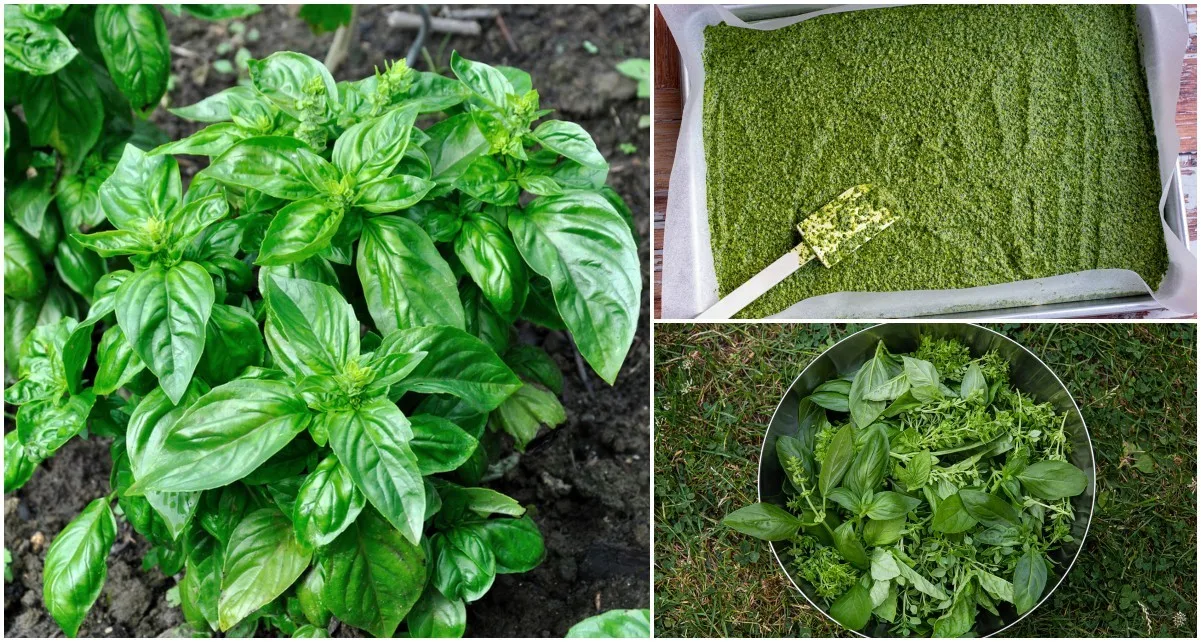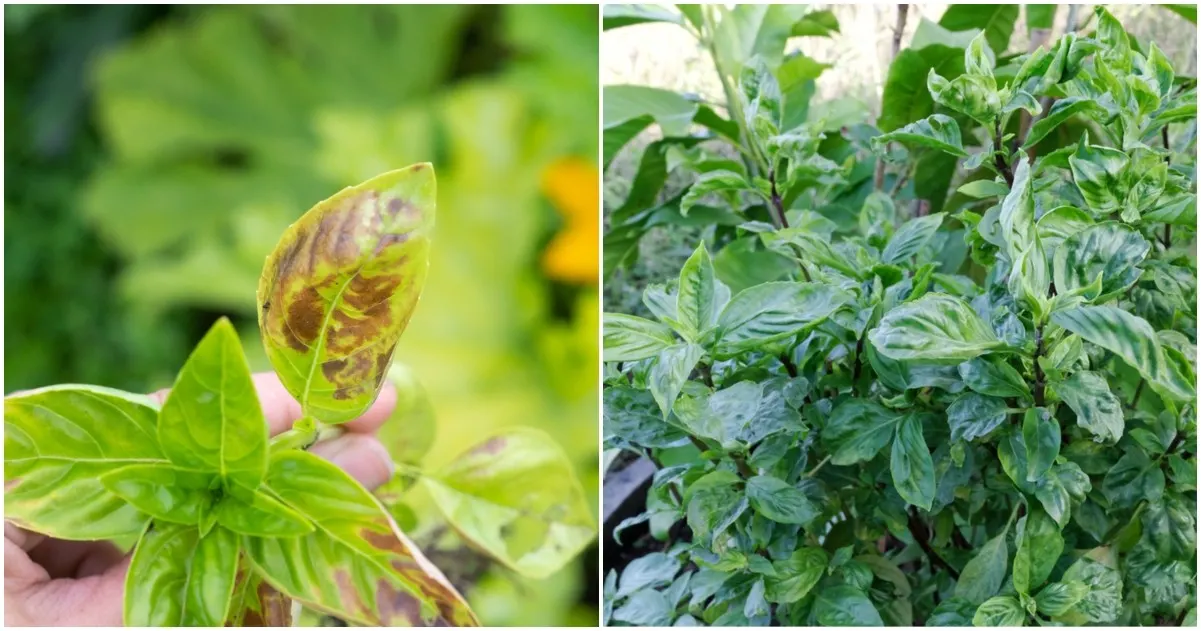
Basil is an annual herb well known for the role it plays in the Italian dish pesto and for use in the cuisines of countries like Thailand, Indonesia and Vietnam.
There are over 60 varieties of basil, with some sporting red or purple leaves, but still the most popular for culinary purposes is the green-leaved sweet basil.
Other basils (including perennial varieties) have different flavored leaves some are even named for the taste they impart – like cinnamon basil, lemon basil and even spicy bush basil.
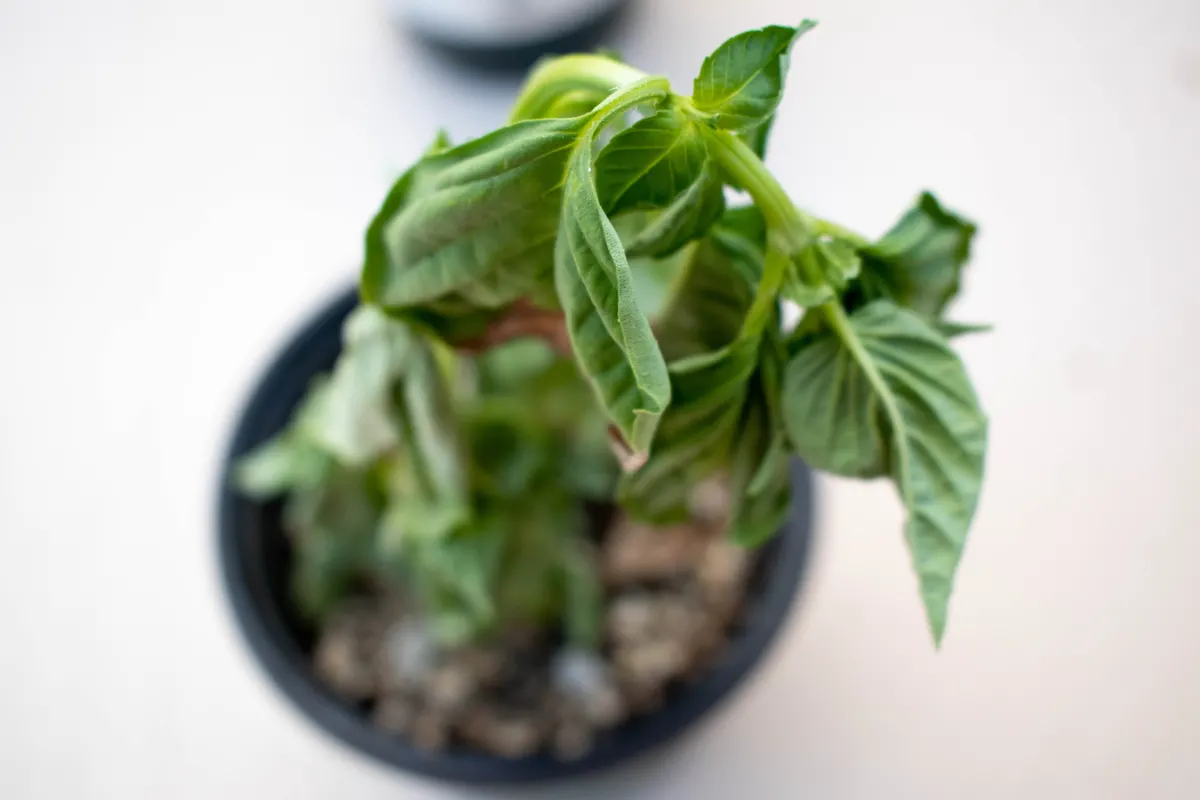
Unfortunately, the leaves – the most useful part of a basil plant – are often the part of the plant that will be attacked with problems. Whether your plants are leggy or your leaves translucent, we’ve got all the potential basil problems and their solutions covered.
1. Leggy Plants
Too Much Fertilizer
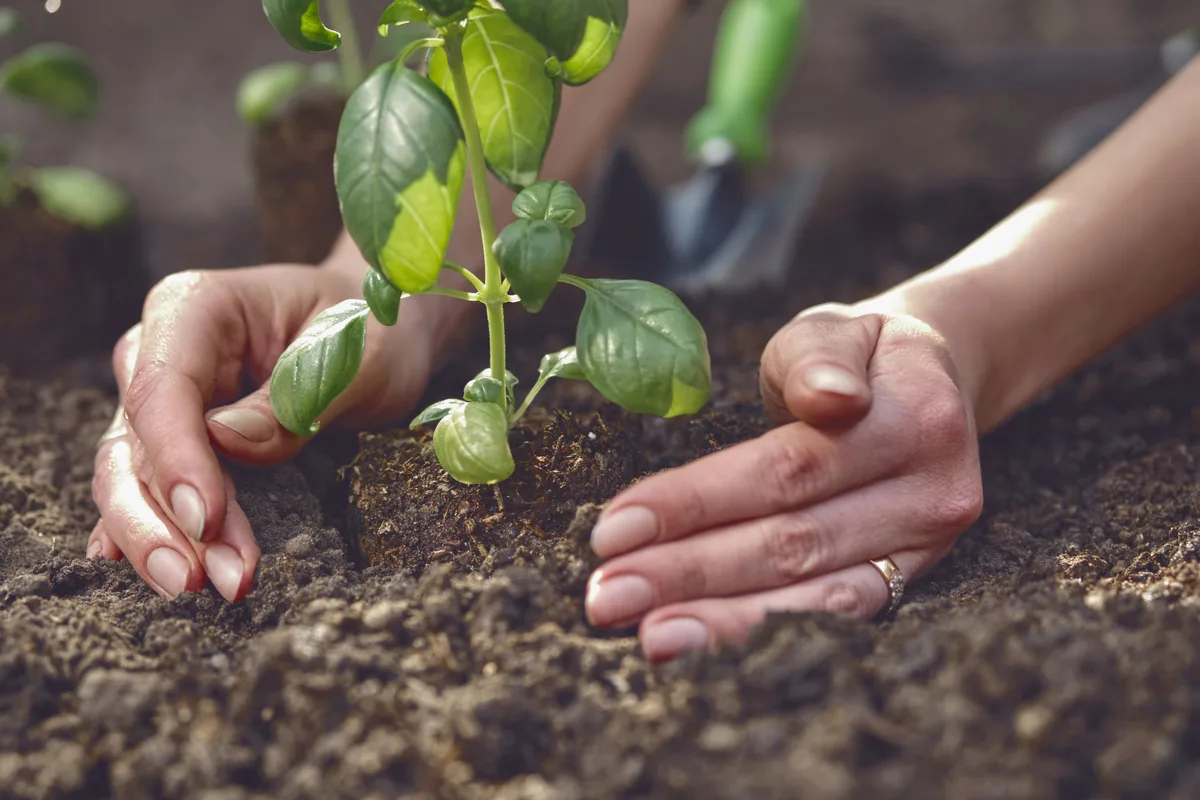
Basils grown outdoors can use an extra dose of fertilizer every so often to keep plants healthy and producing leaves. Depending on the type of fertilizer you choose, this is generally applied once per month or more often during the growing season.
Feeding basil often may create bigger, faster-growing plants. But, they can also grow too fast, becoming leggy with low-quality leaves. The oils in the leaves that give the plants their distinctive flavor will also be reduced with too much fertilizer, resulting in unappetizing leaves.
Always fertilize according to packaging instructions and never apply more than is recommended.
A Drop In Temperature
Variations in temperature can also affect basil plants and inhibit their growth. They are particularly sensitive to dips in temperature, preferring a warmer climate. Make sure to only plant them once the chance of frost has passed to avoid leggy growth after a cold snap. Leave growing to a bit later in spring towards summer or grow in containers that can be moved indoors in cooler overnight temperatures.
Not Enough Sunlight
Basil likes a lot of sunlight – at least 6-8 hours a day of full sun. If the light is not sufficient – often a problem with basil grown indoors – they will become leggy to look for the light. Prune and move to a brighter area and the new growth should return to normal.
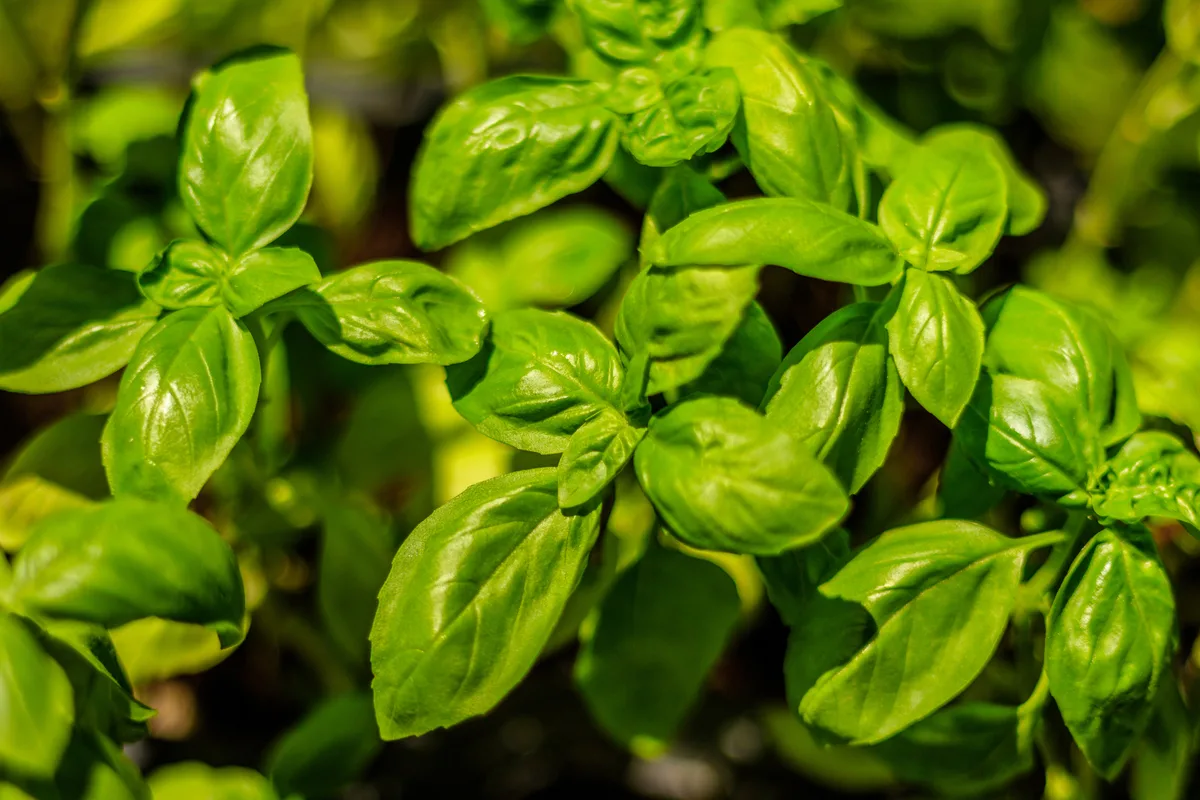
Incorrect Watering Or Lack Of Drainage
Watering basil is a tricky business. They need incredibly well-draining soil, but they also like the soil to be kept moist. This means watering regularly while avoiding the risks of waterlogging. Overwatering will cause the stems to rot, but underwatering will produce leggy stems and a lack of leaves. Also, it’s best to water the soil and not the leaves to prevent fungal disease and stunted growth.
Water deeply as soon as the top of the soil begins to appear dry and never let the soil dry out completely. Mulching your basil plant will help to lock in moisture.
Lack Of Regular Pruning Or Harvesting
One of the most important things to remember to avoid leggy plants is to regularly harvest the leaves. In order for them to grow into bushy, leafy plants, they need to be trimmed often.
By pruning the top of the plants, more light can access the stems and leaves in the center of the plant, increasing their vigor. Pruning also stops the basil from flowering. Once this occurs the leaves turn bitter, so it’s important to prevent flowering for as long as possible.
Luckily, we have the absolute best step-by-step basil pruning guide which will ensure huge basil plants.
2. Yellow Leaves
Lack Of Nutrients
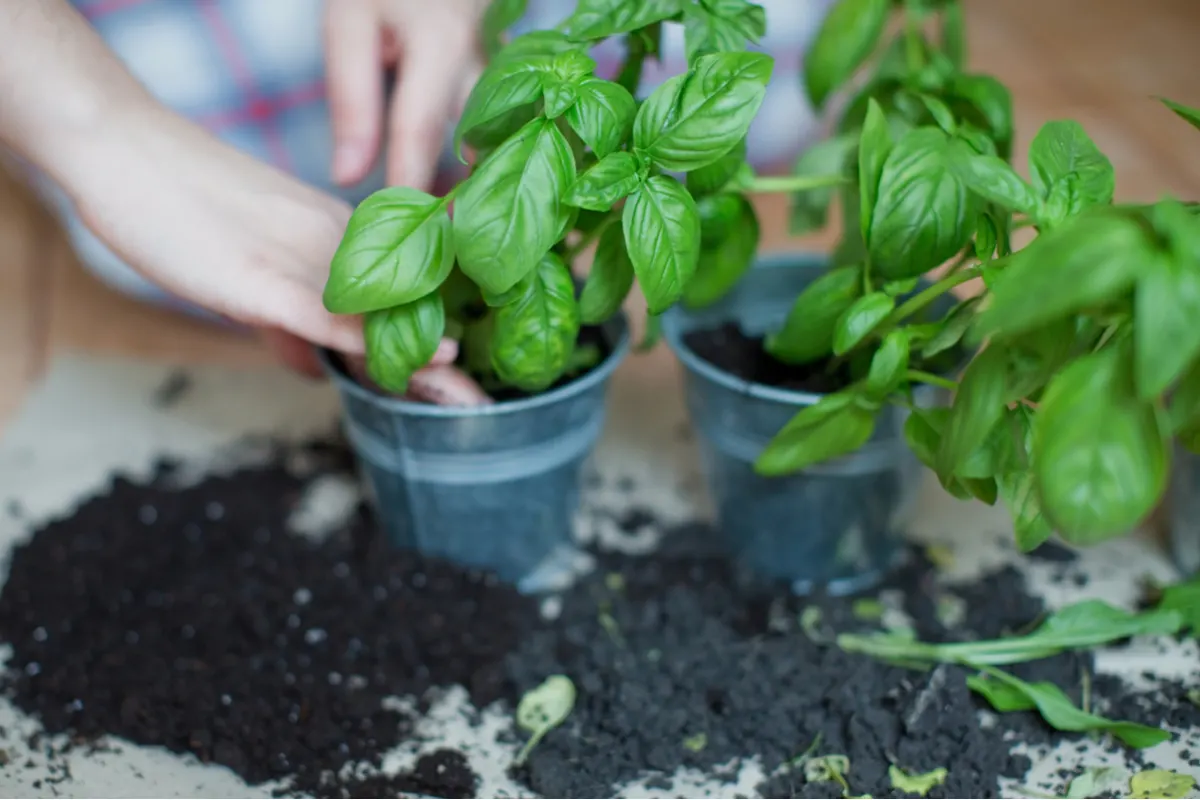
The first step to tackling this problem is the lack of proper nutrients. For basil a balanced fertilizer is optimal, but when it comes to yellowing leaves, the problem is usually caused by a lack of nitrogen. Add a good dose of compost or well-decomposed manure or try a high nitrogen dose of fertilizer. If the problem is not fixed, your yellow leaves may be caused by watering issues.
Watering
Yellow leaves are usually caused by underwatering or overwatering. Due to their love of moisture, underwatering is typically more common, but yellow leaves combined with soggy stems indicate overwatering is the cause. Make sure the soil has good drainage and is moist but not waterlogged. Overwatering could cause root rot, leading to yellowing leaves and the ultimate demise of the plant if the problem is not rectified.
Fungal Infections
Soil-borne fungal diseases attach to the root systems of basil and cause root rot, leaving the basil leaves yellow. Dig up the plant to inspect the roots. If they are brown or slimy your basil has root rot and it’s best to throw out the plant and start over.
The fungal disease downy mildew can cause the same problem. Small, yellow angular spots appear on the upper leaves and greyish mildew usually forms on the underside. The leaves turn yellow and then brown as they curl and wilt. Cut off any infected leaves and treat what remains with an organic fungicide that includes copper.
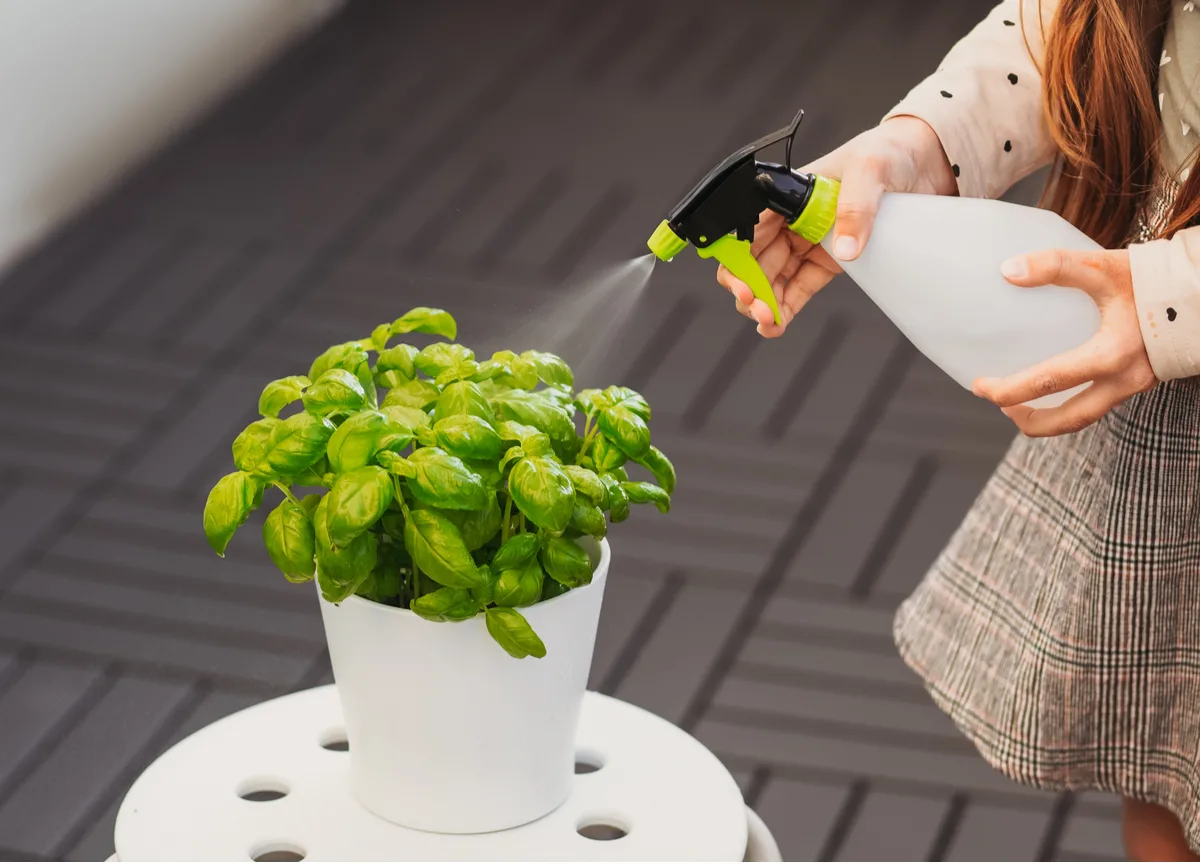
Nematodes
These small pests are found at the base of the plant and in the roots and will cause the leaves to yellow. They can also produce galls on the stems. It is not easy to get rid of the pests and the only option may be to start again with varieties that are nematode-resistant.
3. Black and Brown Spots
Frost
Even a small bit of frost can negatively affect basil. It’s a very sensitive plant and especially vulnerable to dips in temperature. Frost can cause the leaf tips and the tops of the plant to blacken and die.
Plant basil later in the summer season so that the chance of frost is greatly reduced. You can also grow in containers so the pots can be moved indoors when there is a chance of frost.
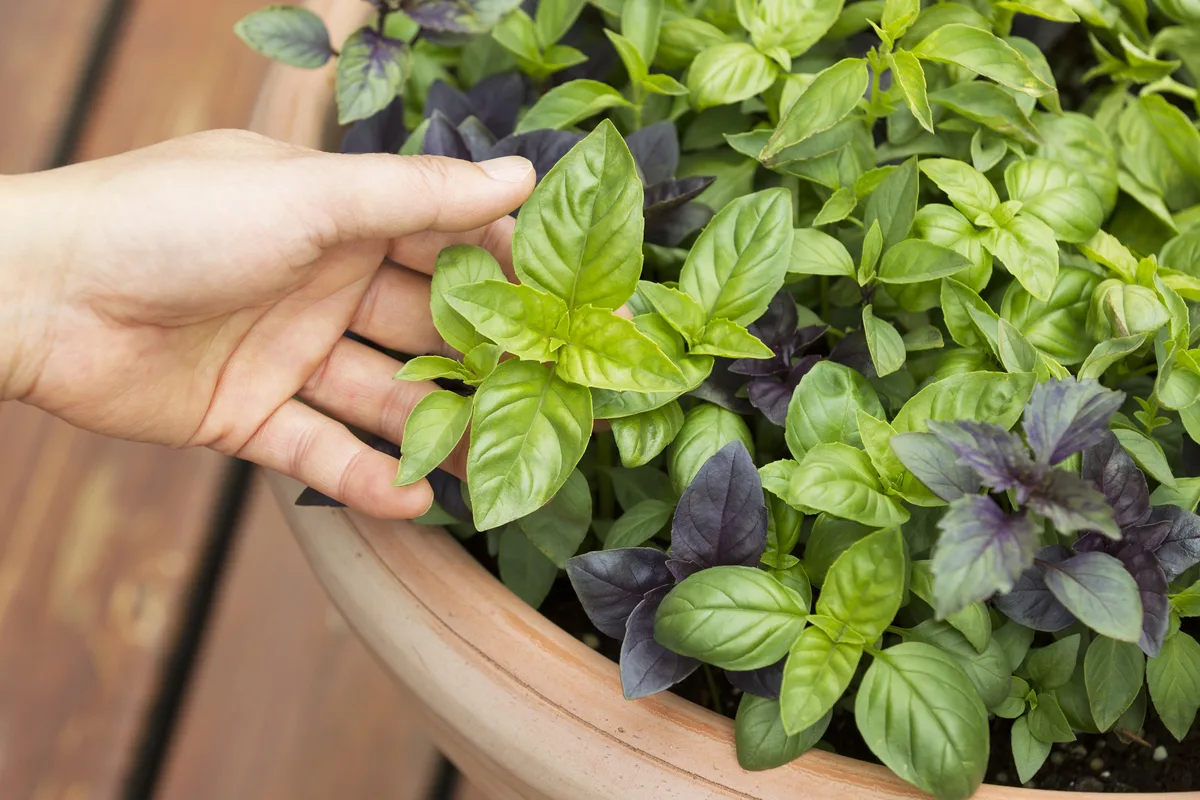
If they are in a garden bed, cover them with frost protection fabric or bell jars if there are any reports of frost to come. If the plant is damaged, cut off all the infected leaves once the cold passes and give it a boost of fertilizer to get the leaves growing again.
Fungal Infection
Black spots from fungal infections usually appear on the underside of the leaves. They are often difficult to identify and could be anything from downy mildew to bacterial blight.
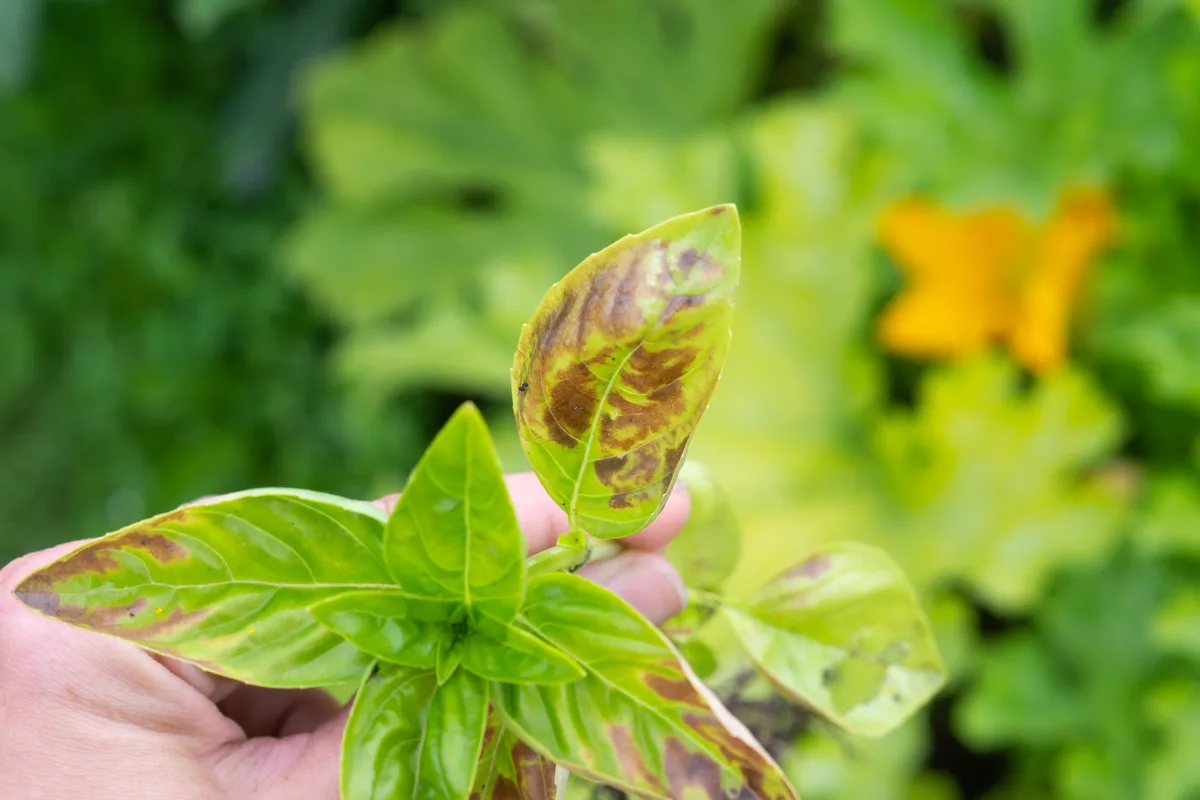
Keep plants well pruned to improve air circulation and make sure they get enough sunlight. Water in the mornings rather than the evenings and only at the base of the plant. As a last resort, use a fungicide that will kill off any diseases.
Inadequate Nutrients
Brown spots on basil leaves are more often than not from a case of either too much nitrogen or too little. Use organic compost to balance out the nutrients and restore the soil to good health. If you think there may be too much fertilizer in nitrogen form (perhaps from a recent fertilizer application), flush the soil with water and hold off on fertilizing for a while.
4. Transparent Spots Or Translucent Leaves
Pests
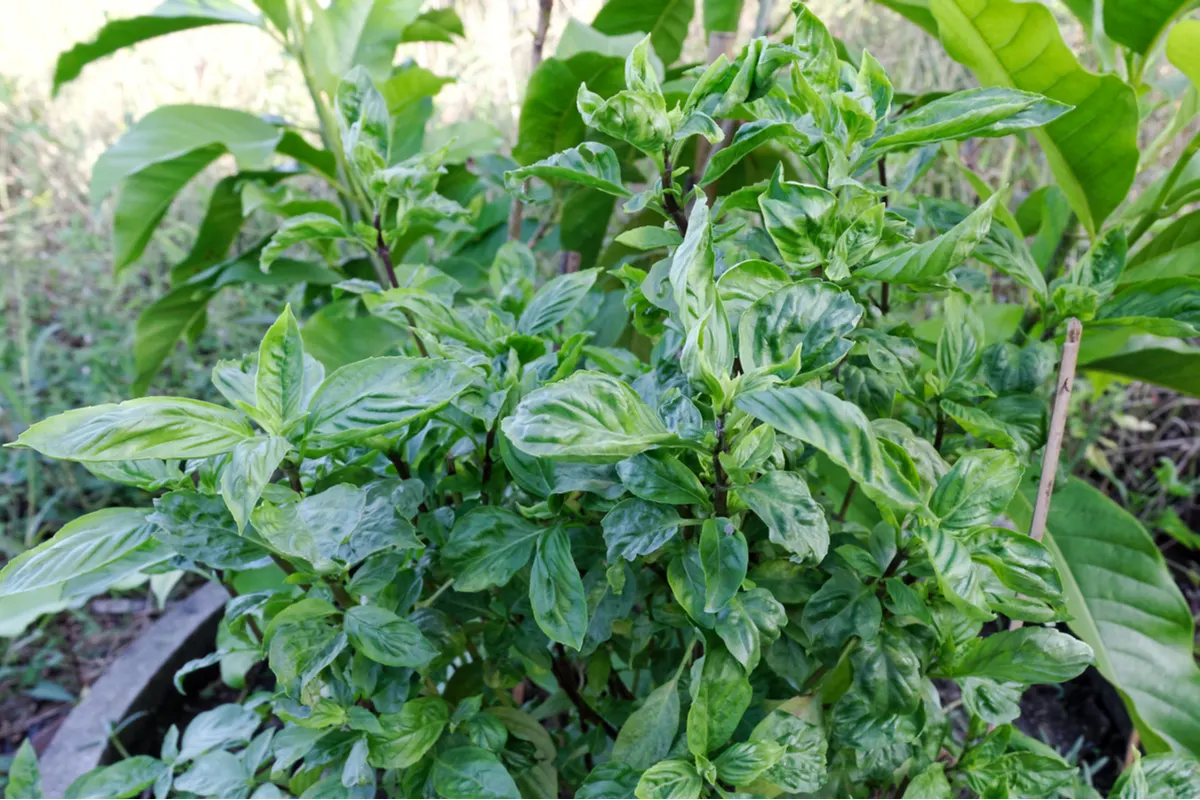
Some insects feed on the leaves by sucking out the chlorophyll, causing transparent spots on the leaves. These insects include spider mites, whiteflies and aphids. Once these sucking insects attack the leaves, the plant becomes stressed and the leaves may turn brown, start curling and fall off.
For spider mites, spray the underside of the leaves with a suitable miticide safe for veggie gardens. More than a single application is usually needed to control the pests.
Infestations of aphids and whitefly can be controlled by an organic insect spray. Alternatively, you can spray the plants with a solution of soapy water or insecticidal soap.
Temperature Fluctuations
Cold drafts are deadly for basil plants. As basil is a tropical plant, any cold snap will stress the plant, and this stress may result in translucent spots on the leaves. For outdoor plants, make sure to cover with frost protection fabric in colder weather. For indoor plants, move out of cold drafts and into a sunnier spot. If this is still a problem, invest in grow lights.
Overwatering
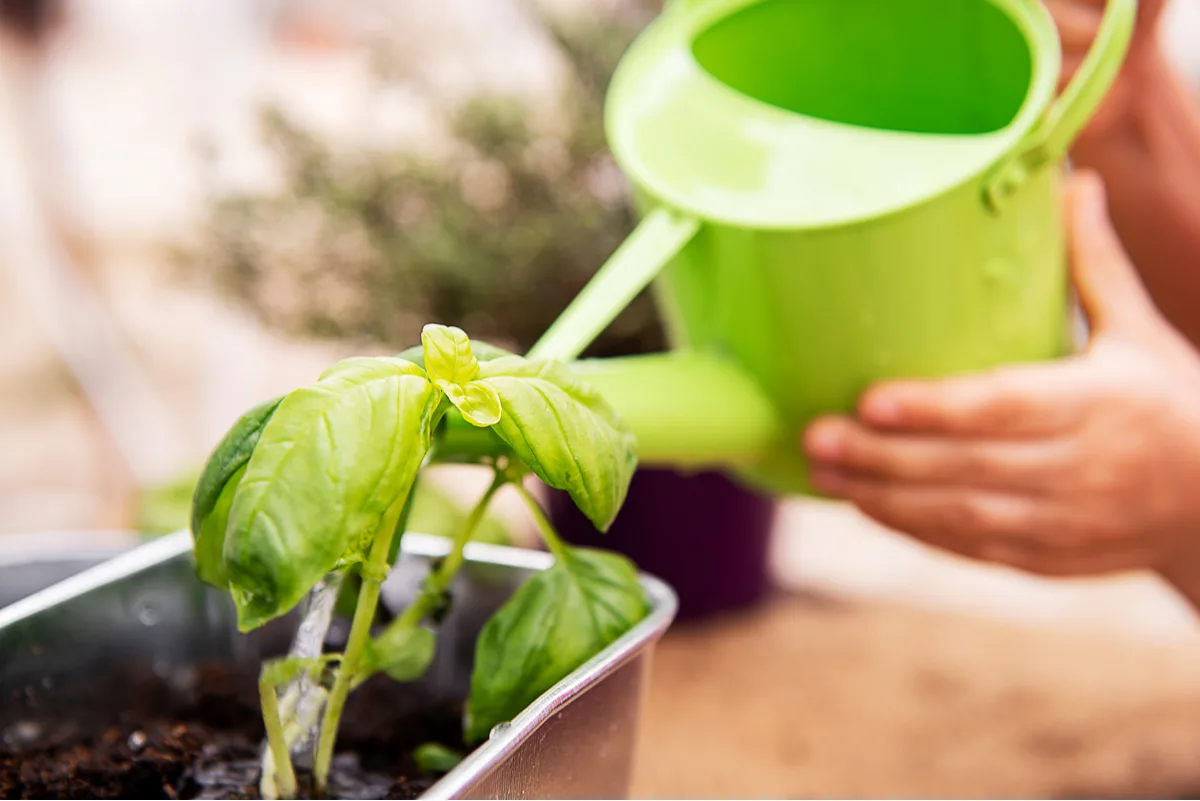
Translucent stems and leaves can also be the result of overwatering. The plant becomes soft and stems and roots start to rot. The roots of the plant will not get enough oxygen to function and they will start suffocating, resulting in dry papery leaves.
Reduce your watering schedule and allow the plant to dry out a bit before watering again. Check that the drainage is sufficient and that, in containers, the water is draining out of the drainage holes. Prune off any damaged leaves and growth should return to normal.
Fungal Infections
Some fungal and bacterial infections could cause the leaves of basil to turn transparent or translucent. Leaf Spot, for example, causes small translucent spots to form on the leaves. These grow bigger and form dark edges. The leaves can turn, brown, black and yellow. Downy mildew can also result in transparent leaves.
Often the cause is high humidity and this is easy enough to regulate by pruning the plants regularly and giving them better ventilation indoors. Also, ensure water does not splash on the leaves when watering, inviting infections to start. Cut off all the infected leaves and if serious, treat with an organic fungicide.
Nutrient Deficiencies
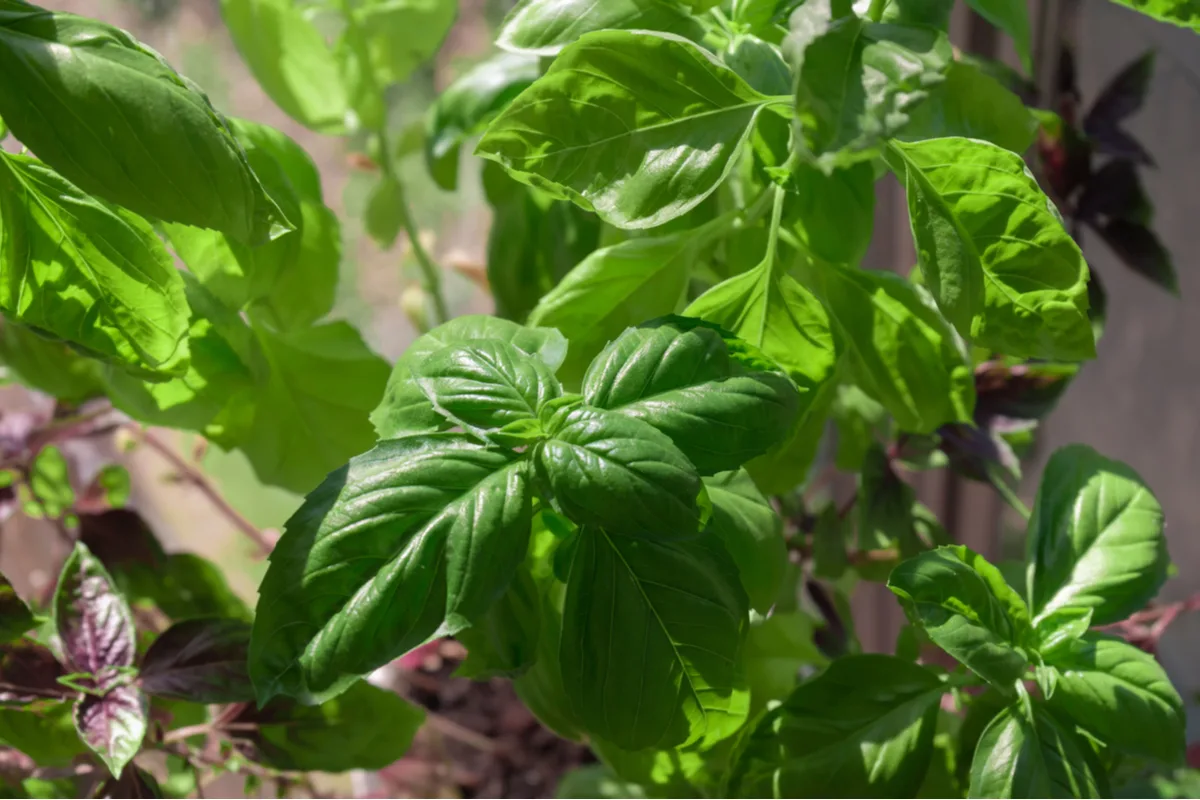
The lack of some nutrients may cause transparent leaves. Nitrogen is essential for healthy green leaves and a lack of it may cause the lower leaves to become transparent while the newer leaves use up the nitrogen resources. Add a few doses of nitrogen-rich fertilizer and additional organic compost to rectify the problem.
In colder climates, basil may suffer from a lack of iron. A deficiency of iron, even though it is a micronutrient, causes stress and can result in the leaves turning transparent and pale in color. To fix the problem it’s best to conduct a pH test on the soil. The soil pH should be above 6.0. Any less and an all-purpose fertilizer, elemental sulfur, or chelated iron will be necessary to increase the acidity in the soil and balance out the nutrients.
5. Curling Leaves
Lack Of Light
Inadequate sunlight (less than 4-5 hours of full sun) will cause leaves to curl or turn yellow and eventually drop off. Check on the amount of light and move containers if necessary. Indoors, if the plants are not getting enough light, it may be better to place them under grow lights.
Lack Of Water
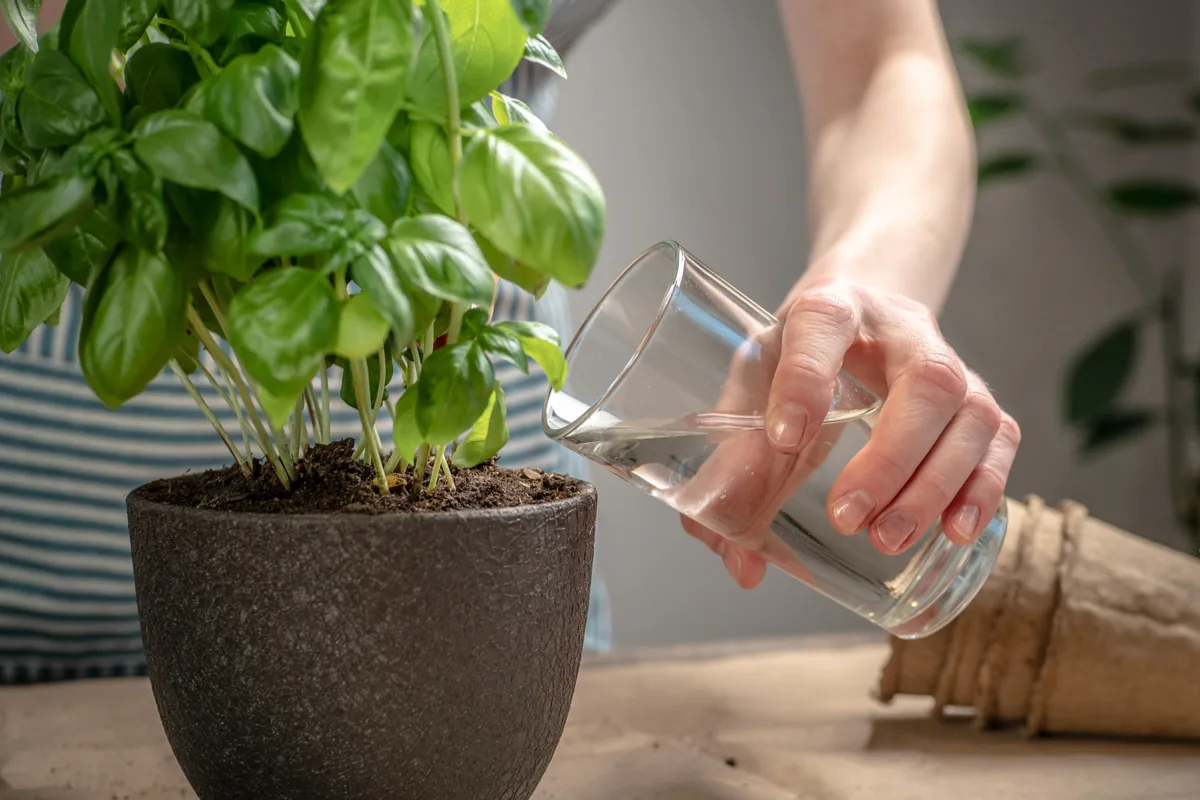
Curling leaves could also be a result of dry soil. Make sure to regularly water basil plants during the growing season to avoid the leaves curling.
Sucking Insects
Pests like aphids, spider mites and even scale that damage the leaves by sucking the chlorophyll out of the leaves could also cause stress and make the leaves curl. Spray with neem oil or use an insecticidal soap over several applications to completely remove the pests.
6. Wilting Leaves
Pests
Some basil pests quite literally suck the life out of the leaves, causing them to wilt. Check for pests like spider mites, aphids and whiteflies and treat the plant immediately to get rid of them.
Fusarium Wilt
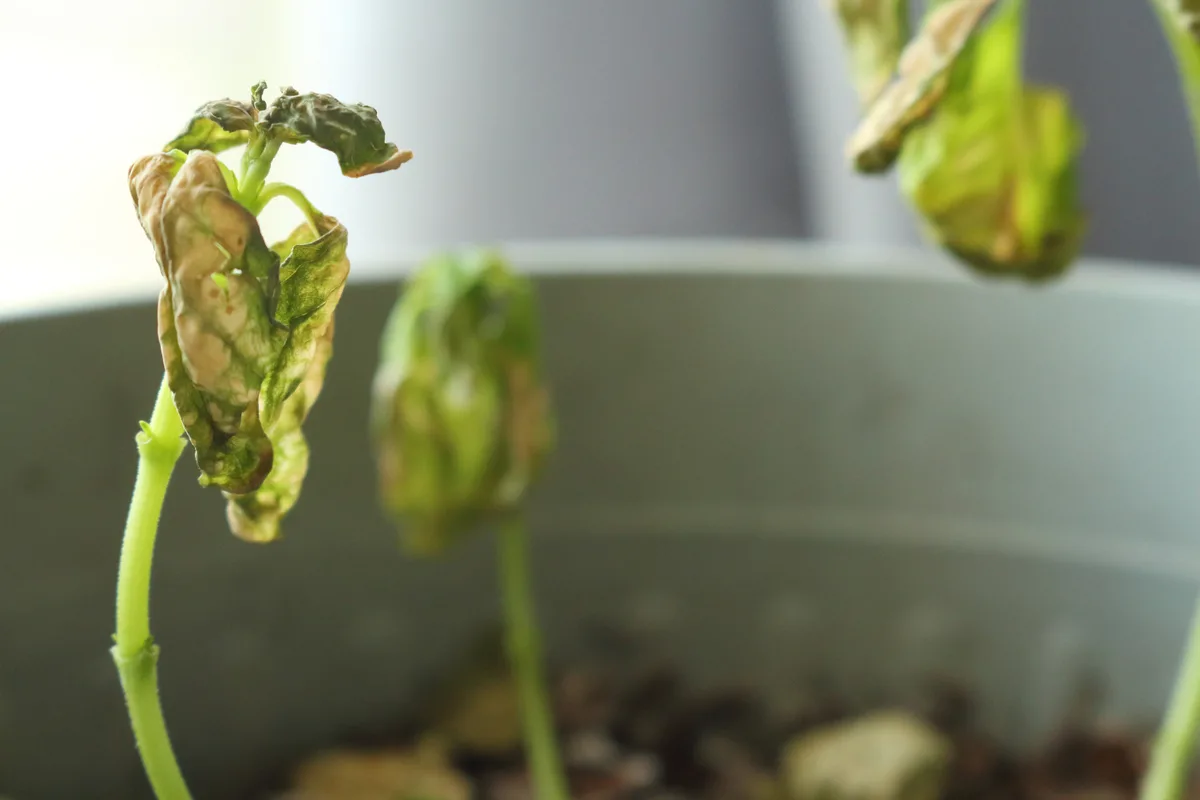
This is a fungal disease that wilts the leaves and can turn them yellow. The stems also become infected, stunting growth. The leaves may even drop off and the plant will eventually die. The bottom leaves will show symptoms first, usually on one side of the plant. Plants will need to be removed and destroyed as there is, unfortunately, nothing that can be done.
Leaf Spot
Spots on the leaves, true to the name, often indicate the infection, Leaf Spot. Once these spots appear, the leaves will start to wilt, becoming more severe over time. Cut off any infected parts of the plant and discard them. Remember not to throw them on the compost heap to avoid spreading the problem.
Root Rot
Mainly caused by overwatering or improper drainage, root rot causes a host of problems for your basil. Unable to draw up more water or nutrients due to the damaged root system, the leaves will start to wilt and the stems will become mushy. To control the spread of this disease, it’s best to replant or repot the plants, cutting off any damaged roots and planting them in fresh soil.
Read Next:

Get the famous Rural Sprout newsletter delivered to your inbox.
Including Sunday musings from our editor, Tracey, as well as “What’s Up Wednesday” our roundup of what’s in season and new article updates and alerts.


